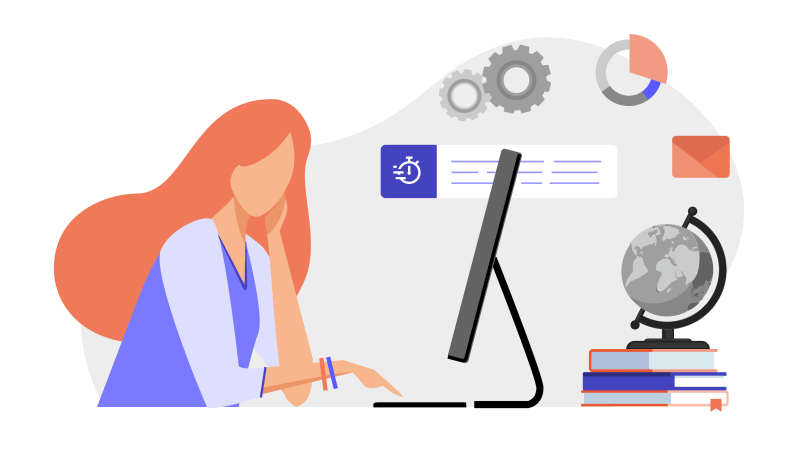Continuous learning
Understand more about continuous learning and the process of learning new skills or knowledge on an on-going basis.

Discover:
- What is continuous learning?
- Why is continuous learning important for organizations?
- Benefits of continuous learning
- What are the benefits of continuous learning for the organization?
- What are the benefits of continuous learning for the individual?
- Continuous learning examples
- What is the difference between lifelong learning and continuous learning?
- How to build a continuous learning environment within the organization?
What is continuous learning?
Continuous learning is the process of learning new skills and knowledge on an on-going basis. This can come in many forms, from formal course taking to casual social learning. It involves self-initiative and taking on challenges.
Continuous learning can also be within an organization, or it can be personal, such as in lifelong learning.

Why is continuous learning important for organizations?
Staying competitive in today’s global marketplace means that organizations need to be innovative, adaptive, and ever-changing. Achieving this depends on the skill and knowledge of the workforce. But how do you get this kind of workforce to begin with?
To innovate, to try a new process, or to do something new all requires learning.
People need to learn new knowledge or skills in order to see things in a new light and take that next leap.
When organizations do not support a continual process of learning, innovation does not happen, processes remain unchanged, and nothing new is ever accomplished.
Employees need to be able to challenge themselves in order to obtain new knowledge, ideas, and skills. Learning needs to be on a flexible, on-demand and continual basis in order to contribute this kind of cutting-edge performance.
Benefits of continuous learning
Benefits for the organization
Creating a learning culture within the organization is an effective way to improve performance and innovation, as mentioned earlier, but also employee satisfaction and retention. Here’s why:
- Knowledge is power – The more employees know and the more they can do, the more they can contribute to the organization.
- More cost effective – Investing in the development of employees is less expensive than rehiring and retraining new employees.
- Show that employees are valued – Support of continuous learning indicates that employees are worth the investment and that the organization is genuine about employee career development.
Benefits for the individual
Continuously updating knowledge or skills can help an employee in both their professional life and personal life for a number of reasons. Here’s why:
- Top Performer – Developing new skills and knowledge can increase personal performance or competence on the job.
- Career development – Additional training, education, or skill development can help achieve goals for those pursuing a career path or wanting to rotate into a new position.
- Licenses or Certifications – Pursuing additional learning is also important for those employees who need to obtain or update professional licenses or certifications.
- Promotions or incentives – Spending time to learn a new skill or obtain new knowledge can benefit work performance and influence future promotion or financial incentives.
- Personal enrichment – Often a person’s interests extend beyond the job they do on a daily basis. Pursuing extracurricular interests can lead to insight and developments that open the door to new, future opportunities.
- Stay marketable – Staying current in the trends and advances of one’s profession can help an employee stay marketable in their profession should anything change.

Build a learning culture: a practical workbook for your organization
Upgrade your organization’s learning culture with clear, actionable strategies to address the challenges.
Download workbookContinuous learning examples
Let’s take a look at the different ways an employee can engage in continuous learning:
Formal learning
Formal learning includes the ways a learner can gain new knowledge and skills via learning initiatives that have already been pre-determined, organized and implemented for a specific learning purpose or goal. This can include:
- a university or college course
- training programs from within the organization
- external workshops or conferences
- e-Learning courses
- Mobile learning courses
- MOOC’s
Social learning
Social learning includes all the ways a learner interacts, discusses, collaborates and learns from others to increase knowledge or learn new skills. This can be both formal and informal, including:
- Discussion and collaboration on social media
- Finding blogs or other resources to gain deeper insight
- Working with other co-workers
- Coaching and mentoring
- On-the-job training
Self-directed learning
Obtaining a new skill or improving your knowledge and understanding of something does not have to be restricted to formal training or working with others. Self-directed learning can include:
- Researching and reading to gain a deep understanding of a topic.
- Listening to topic relevant podcasts or watching instructional videos
- Experimentation and exploration
What is the difference between lifelong learning and continuous learning?
Lifelong learning and continuous learning are often terms used interchangeably. They can sometimes have a slightly different meaning depending on the context.
Let’s compare the differences below:
Lifelong learning
The term lifelong learning is geared more towards the individual level. It refers to someone who makes a long-term, voluntary commitment to learning new skills or acquiring new knowledge.
A lifelong learner is someone who incorporates continuous learning as part of their lifestyle.
An example of lifelong learning could be someone who chooses to read about something new for one hour every day. This is a personal commitment for self-betterment or long-term improvement.
Continuous learning
The term continuous learning can also refer to someone who is committed to learning new skills or knowledge but is often used in a more temporary context or formal context.
An example of continuous learning could be someone who is taking an extra training course for their job. This is a formal commitment, sometimes temporary, that is taken on to achieve new skills.
How to build a continuous learning environment within the organization
Creating a supportive environment that encourages employees to engage in continuous learning takes commitment, resources, and coaching.
Some employees will be self-motivated and will take up continuous learning on their own time, but the majority will not have the time or resources to do so.
Employees are typically focused on the job or tasks at hand and do not want to be seen as wasting time.
It is unrealistic to expect all employees to engage in continuous learning either during the work day or in their free time.
This is a good starting point when figuring out how to start building a learning environment. Let’s take a look at some ideas on how to navigate this situation:
1. Continuous learning begins with leaders
When employees see that their Manager or Supervisor is fully engaged and supportive of learning and development initiatives, it creates an atmosphere that promotes continuous learning.
Sometimes it is difficult for employees to take time away from daily work tasks because there is an impression that management may not approve.
Show employees that it is important and valued by becoming a role model.
2. Create a learning plan
When continuous learning becomes part of the way a business runs, employees are more apt to engage in it.
This means defining the business goals of what is hoped to be achieved and creating an actionable plan around how to support it.
Engaging in dialogue about continuous learning means that employees will not only see that the organization is genuine about supporting learning initiatives, but that efforts are being offered to make it a reality.
The plan can include what resources or support individuals maybe need or the types of learning that can be offered, such as mobile learning or mentoring.
3. Provide the resources and time for continuous learning
The main component of creating a learning environment is time and resources. These need to be available to employees.
This can come in all shapes and forms, depending on the needs of the organization, department, or individual employees.
Some ideas include:
- Establish a personal development plan with each employee to identify what they may want to learn in order to foster encouragement and initiative
- Hold Lunch & Learns during the lunch break to encourage employees to present and apply what they’ve learned
- Devote dedicated time to employees to engage in training or learning
- Attend team workshops or events
- Provide access to professional resources via subscriptions or memberships
- Provide access to online learning for self-paced courses
- Organize mentorship or coaching opportunities
- Create a learning “task-force” that enables employees to investigate and collaborate on a topic

Build a learning culture: a practical workbook for your organization
Upgrade your organization’s learning culture with clear, actionable strategies to address the challenges.
Download workbook



